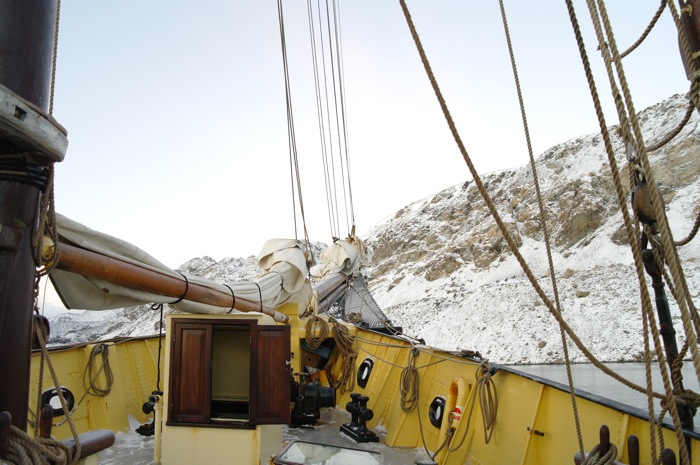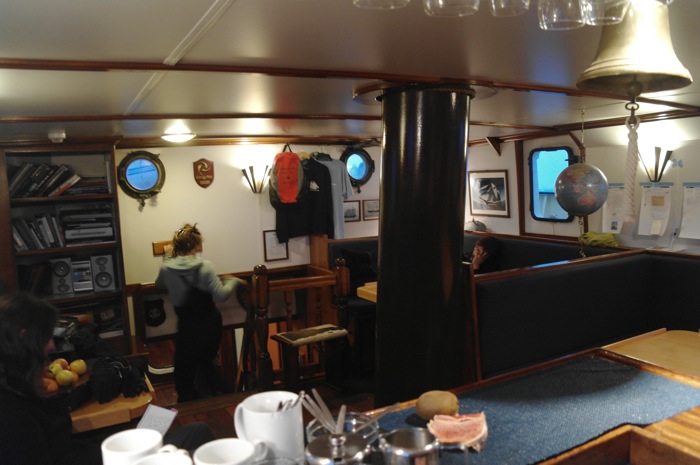15 October 2010 – Hornbaekpollen, Liefdefjorden
 First Mate Barbara is singing along to ‘Mama said there’d be days like this’ in the galley. Jan, our guide, is eating orange cake and wiggling his bum in time. Anna is wearing a red and white striped shirt. Arjen is photographing Wendy at her computer. Wendy has a serious expression and her style on the touchpad is to use her thumb and forefinger, with the other three fingers extended. The song changes to ‘You don’t own me’; Barbara really has a good voice. Wendy turns on her recorder. The sound of dishes clunking in the sink reminds me of the ice clunking around the ship and the fjord.
First Mate Barbara is singing along to ‘Mama said there’d be days like this’ in the galley. Jan, our guide, is eating orange cake and wiggling his bum in time. Anna is wearing a red and white striped shirt. Arjen is photographing Wendy at her computer. Wendy has a serious expression and her style on the touchpad is to use her thumb and forefinger, with the other three fingers extended. The song changes to ‘You don’t own me’; Barbara really has a good voice. Wendy turns on her recorder. The sound of dishes clunking in the sink reminds me of the ice clunking around the ship and the fjord.
Life onboard:
I share a cabin with Janet Biggs, an adventurous New Yorker – dare I say a kind of contemporary-art action hero, who took part in the trip last year too. I know her work a little already, having seen her video installation, Anana Dream, at Perth Institute of Contemporary Art (PICA) – in which a pair of captive polar bears swims their disturbing, sad dance ad infinitum, describing the circuit of a small blue pool in a zoo. Janet has a lot of stuff onboard, but we have the biggest cabin on the ship (the size of a large broom-cupboard).
So the cabin looks like this: a roomy top bunk (mine) above which is a covered window-hatch letting in a stream of soft, cold air. I have a hand-towel draped on top of the little horizontal curtain, soaking up the condensation, and a stretch clothesline tangled in three directions around the curtain rails, from which dangle goretex gloves, damp socks, a flannel, and rinsed-out smalls. My suitcase sits at the end of the bed, neatly stacked inside like a deep drawer. At night I stand it on end so that I can stretch my legs out to sleep. Next to the suitcase are jammed my camera case and a plastic bag full of books. At the head, between the mattress and the wall, are my computer sleeve with pocket for pens, earplugs, mouse, earphones, mobile phone (merely a clock at this point), and seabands. Then there is still space along the side-rail to stuff my laptop power supply, my glasses and a bottle of water.
The bottom bunk is Janet’s. She doesn’t have much headroom (I can sit cross-legged on my bed and write, and I don’t know how I would cope without this small luxury) but she doesn’t mind the ‘den’ feel down there, her bunk is a cubby she slides into sideways and is wrapped up cosy. Janet’s bed has always got chunky cameras lying all over it; she has slung a stretch rope from one end to the other and between the twists are her damp bits and pieces, much more serious than mine: mostly chunks of neoprene related to the assortment of hard-core survival gear she has hung up behind the door.
We’ve got a system of clip-on lights to illuminate our shelves – this means we can come in and out when one of us is sleeping, and find the stuff we need. My top shelf is full of footwear – snowboots + felt liners, neoprene and rubber waterproof boots, fur lined ankle boots and rubber soled slippers. My bottom shelf holds toiletries, snacks, empty water bottles and a plastic bag full of hats and gloves. On the few square feet of floorspace, we edge around one another’s rear ends or toothbrushes with kindness and tact, we make jokes about all our junk and our need for more sleep, and very quickly develop a kind of sisterhood catalysed by the complete absence of privacy.
The first morning, Janet set her alarm clock for 7.15am, 3/4 hour before breakfast, so I got up too. Then it drifted to around 7.30, and then 7.45, and before long one of us was waking the other at ten to eight, and this morning both of us were crashed out completely until we heard the bell go at eight. I’ve been sick the past two days, so have steadied the pace. I no longer try to do everything – I’ve spent today, in the very middle of the trip, onboard, while almost everyone else went out. It gave me a chance to start thinking about how I am going to write this work. Although I did nothing on Moffen, wrote nothing, thought nothing, it has become a kind of turning point. The furthest point north, sitting there on a tiny blot of an island in the middle of nowhere, it seems there was nowhere further to go, nothing to think there. The ‘Nest Upon the Sea’ was somewhere to the south, and up here, reaching this point, there is no more theory, only driftwood, the next harbour or sheltered fjord, the next storm or pointed mountain, and somewhere, home.
§
In Irigaray, The Way of Love, p. 91:
In western thought: “Thus man always wanders further away from himself towards some remote universal, forgetting that in which he belongs to the most near, forgetting that this most near is in himself or beside him, mingled with what he is.”




